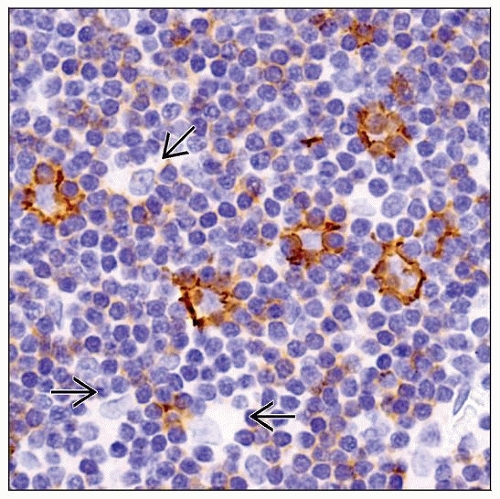T-cell/Histiocyte-rich Large B-cell Lymphoma
Francisco Vega, MD, PhD
Key Facts
Terminology
Large B-cell lymphoma characterized by scattered large lymphoma cells representing < 10% of total cell population
Clinical Issues
Young to middle-aged males
Usually aggressive and often refractory to chemotherapy
Liver, spleen, and bone marrow often involved
Microscopic Pathology
Diffuse pattern
Large lymphoma cells have variable cytologic features
Centroblasts, immunoblasts, or HRS-like
Reactive cells are small lymphocytes and histiocytes
Histiocyte number can be variable
Ancillary Tests
Large lymphoma cells are B cells
Positive for CD20, CD79a, pax-5, and other pan-B-cell markers
CD45/LCA positive; CD15 negative
Bcl-6 usually positive; CD10 variable
CD30 often negative but can be positive in subset
Negative for T-cell antigens
Reactive lymphocytes are T cells and histiocytes
Top Differential Diagnoses
Classical Hodgkin lymphoma
Nodular lymphocyte-predominant Hodgkin lymphoma
Diffuse large B-cell lymphoma, NOS
Angioimmunoblastic T-cell lymphoma
TERMINOLOGY
Abbreviations
T-cell/histiocyte-rich large B-cell lymphoma (THRLBCL)
Synonyms
T-cell-rich B-cell lymphoma
Large B-cell lymphoma rich in T-cells and simulating Hodgkin disease
Histiocyte-rich T-cell-rich B-cell lymphoma
Histiocyte-rich B-cell lymphoma
Definitions
Large B-cell lymphoma characterized by scattered large cells representing < 10% of total cell population
CLINICAL ISSUES
Presentation
Young to middle-aged males
Advanced clinical stage at diagnosis
Commonly involves liver, spleen, and bone marrow
Treatment
Rituximab, cyclophosphamide, doxorubicin, vincristine, and prednisone (R-CHOP) is standard
Prognosis
Clinically aggressive and often refractory to chemotherapy
MICROSCOPIC PATHOLOGY
Histologic Features
Diffuse pattern of growth replacing lymph node parenchyma
Small number of large lymphoma cells
May resemble centroblasts, immunoblasts, or Hodgkin cells including LP (a.k.a. L&H or “popcorn” cells)
By definition, < 10% of total cell population
Stay updated, free articles. Join our Telegram channel

Full access? Get Clinical Tree







